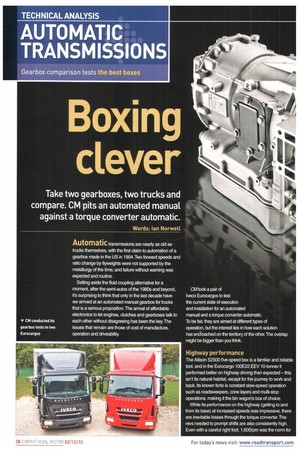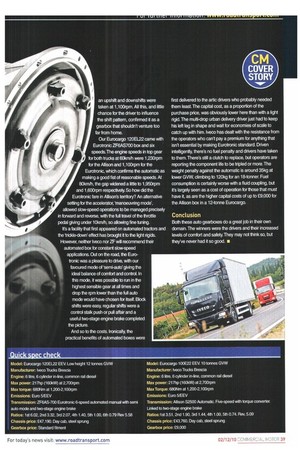Boxing clever
Page 38

Page 39

If you've noticed an error in this article please click here to report it so we can fix it.
Take two gearboxes, two trucks and compare. CM pits an automated manual. against a torque converter automatic.
Words: Ian Norwell
Automatic transmissions are nearly as old as trucks themselves, with the first claim to automation of a gearbox made in the US in 1904. Two forward speeds and ratio change by flyweights were not supported by the metallurgy of the time, and failure without warning was expected and routine.
Setting aside the fluid coupling alternative for a moment, after the semi-autos of the 1980s and beyond, it's surprising to think that only in the last decade have we arrived at an automated manual gearbox for trucks that is a serious proposition. The arrival of affordable electronics to let engines, clutches and gearboxes talk to each other without disagreeing has been the key. The issues that remain are those of cost of manufacture. operation and dnveability. CM took a pair of lveco Eurocargos to test the current state of execution and installation for an automated manual and a torque converter automatic.
To be fair, they are aimed at different types of operation, but the interest lies in how each solution has encroached on the territory of the other. The overlap might be bigger than you think
Highway performance
The Allison S2500 five-speed box is a familiar and reliable tool. and in the Eurocargo 100E22 EEV 10-tonner it performed better on highway driving than expected — this isn't its natural habitat, except for the journey to work and back. Its known forte is constant slow-speed operation such as roadsweepers, cone layers and multi-stop operations, making it the bin wagon's box of choice.
While its performance on the highway (getting to and from its base) at increased speeds was impressive, there are inevitable losses through the torque converter. The revs needed to prompt shifts are also consistently high. Even with a careful right foot, 1,600rprn was the norm for an upshift and downshifts were taken at 1,100rpm. All this, and little chance for the driver to influence the shift pattern, confirmed it as a gearbox that shouldn't venture too far from home.
Our Eurocargo 120EL22 came with Eurotronic ZF6AS700 box and six speeds. The engine speeds in top gear for both trucks at 60km/h were 1,230rpm for the Allison and 1,100rpm for the Eurotronic, which confirms the automatic as making a good fist of reasonable speeds. At 80km/h, the gap widened a little to 1,950rpm and 1,600rpm respectively. So how did the Eurotronic fare in Allison's territory? An alternative setting for the accelerator, 'manoeuvring mode', allowed slow-speed operations to be managed precisely in forward and reverse, with the full travel of the throttle pedal giving under 10km/h, so allowing fine tuning Ifs a facility that first appeared on automated tractors and the tickle-down' effect has brought it to the light ngids. However, neither Iveco nor ZF will recommend their automated box for constant slow-speed applications. Out on the road, the Eurotronic was a pleasure to drive, with our favoured mode of 'semi-auto' giving the ideal balance of comfort and control. In this mode, it was possible to run in the highest sensible gear at all times and drop the rpm lower than the full auto mode would have chosen for itself. Block shifts were easy, regular shifts were a control stalk push or pull affair and a useful two-stage engine brake completed the picture.
And so to the costs. Ironically, the practical benefits of automated boxes were first delivered to the artic drivers who probably needed them least. The capital cost, as a proportion of the purchase price, was obviously lower here than with a light rigid. The multi-drop urban delivery driver just had to keep his left leg in shape and wait for economies of scale to catch up with him. Iveco has dealt with the resistance from the operators who can't pay a premium for anything that isn't essential by making Eurotronic standard. Driven intelligently, there's no fuel penalty and drivers have taken to them. There's still a clutch to replace, but operators are reporting the component life to be tripled or more. The weight penalty against the automatic is around 35kg at lower GVW, climbing to 120kg for an 18-tonner. Fuel consumption is certainly worse with a fluid coupling, but it's largely seen as a cost of operation for those that must have it, as are the higher capital costs of up to £9,000 for the Allison box in a 12-tonne Eurocargo.
Conclusion
Both these auto gearboxes do a great job in their own domain The winners were the drivers and their increased levels of comfort and safety. They may not think so, but they've never had it so good. •
































































































































